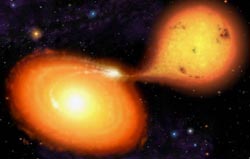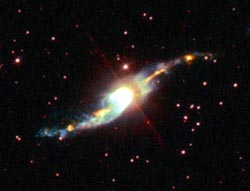This area deals with the fundamental laws and building blocks of nature and how they interact, the properties and the behavior of matter, and research into space and time and their structures.
innovations-report provides in-depth reports and articles on subjects such as astrophysics, laser technologies, nuclear, quantum, particle and solid-state physics, nanotechnologies, planetary research and findings (Mars, Venus) and developments related to the Hubble Telescope.

Astronomers led by the University of Colorado and Carnegie Observatories have shown that a miniature galaxy less than one-hundredth the size of the Milky Way is ejecting large quantities of gas and energy into huge regions of intergalactic space.
“This discovery suggests tiny galaxies that appear very faint and dormant today were once much brighter and more active,” said CU-Boulder graduate student Brian Keeney. “It also indicates similar galaxy systems may have been primarily responsible fo

Astronomers Steve Howell of the University of California, Riverside and Thomas E. Harrison and Heather Osborne of New Mexico State University have found from their observations of over a dozen mass-losing stars in ’cataclysmic variables’ that most of the secondary stars do not appear to be normal main sequence stars in terms of their apparent abundances. To various degrees, each star seems to have low to no carbon and other odd mixtures of elements such as sodium and calcium, the astronomer

Niobium clusters display non-metallic properties at ultra-cold temperatures
The May 23 issue of the journal Science answers that question with an account of the surprising behavior exhibited by nanometer-scale clusters of the metal niobium. When the clusters are cooled to below 20 degrees Kelvin, electrical charges in them suddenly shift, creating structures known as dipoles.
“This is very strange, because no metal is supposed to be able to do this,” said Walter de Heer, a p

Images made by NASA’s Chandra X-ray Observatory have revealed two distant cosmic construction sites buzzing with activity. This discovery shows how super massive black holes control the growth of massive galaxies in the distant universe.
X-rays were detected from vast clouds of high-energy particles around the galaxies 3C294 and 4C41.17, which are 10 and 12 billion light years from Earth, respectively. The energetic particles were left over from past explosive events that can be traced

Ultracold experiment opens door for basic studies in quantum computing
Physicists at Rice University have completed the first real-time measurement of individual electrons, creating an experimental method that for the first time allows scientists to probe the dynamic interactions between the smallest atomic particles.
The research, which appears in the May 22 issue of the journal Nature, is important for researchers developing quantum computers, a revolutionary type of compu

There are many mysterious objects seen in the night sky which are not really well understood. For example, astronomers are puzzled by the “jets” emerging from planetary nebulae. However, the S-shaped jet from Henize 3-1475 is the most perplexing of all.
“Jets” are long outflows of fast-moving gas found near many objects in the Universe, such as around young stars, or coming from black holes, neutron stars, and planetary nebulae, for example. The NASA/ESA Hubble Space Telescope has imaged th